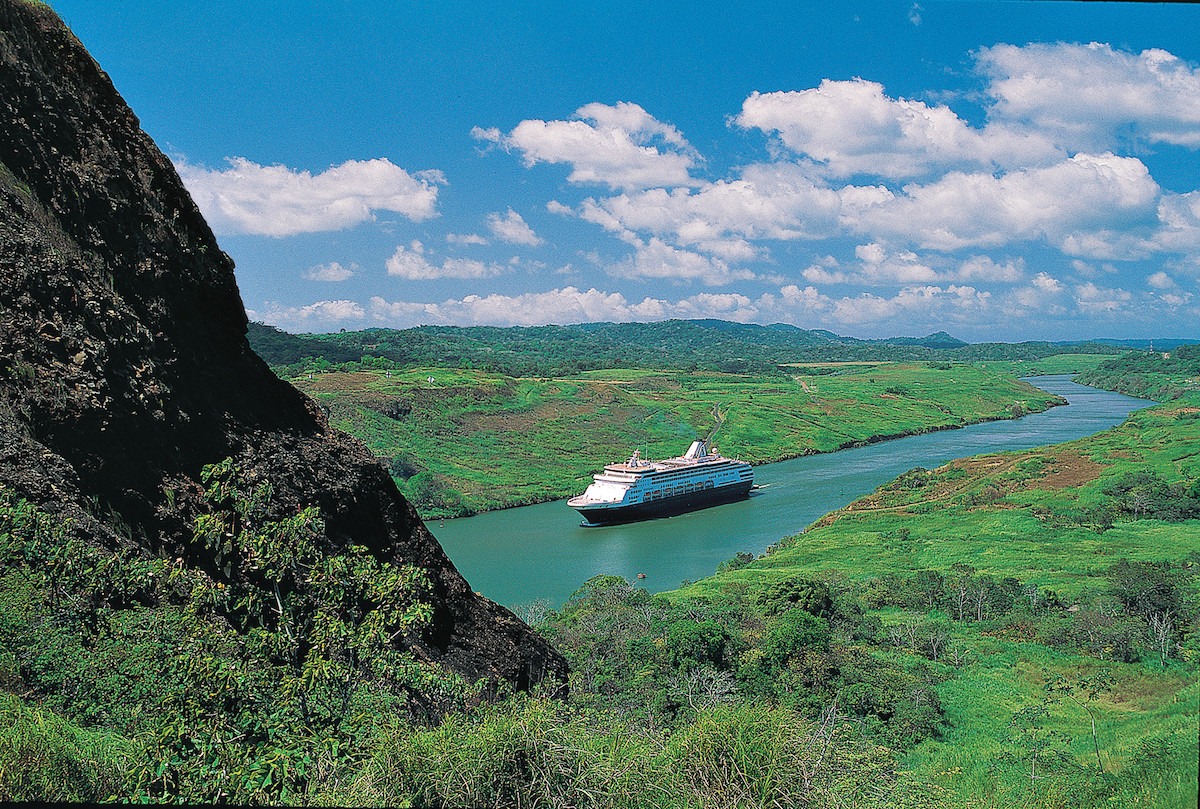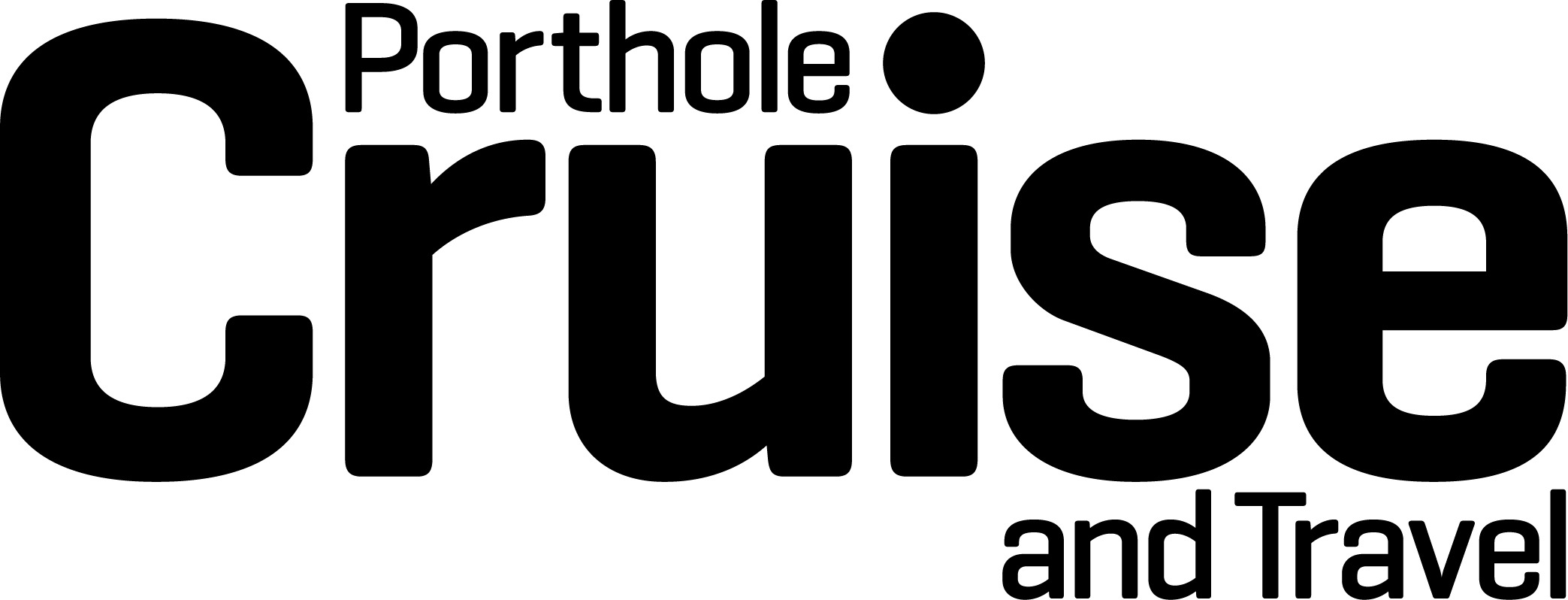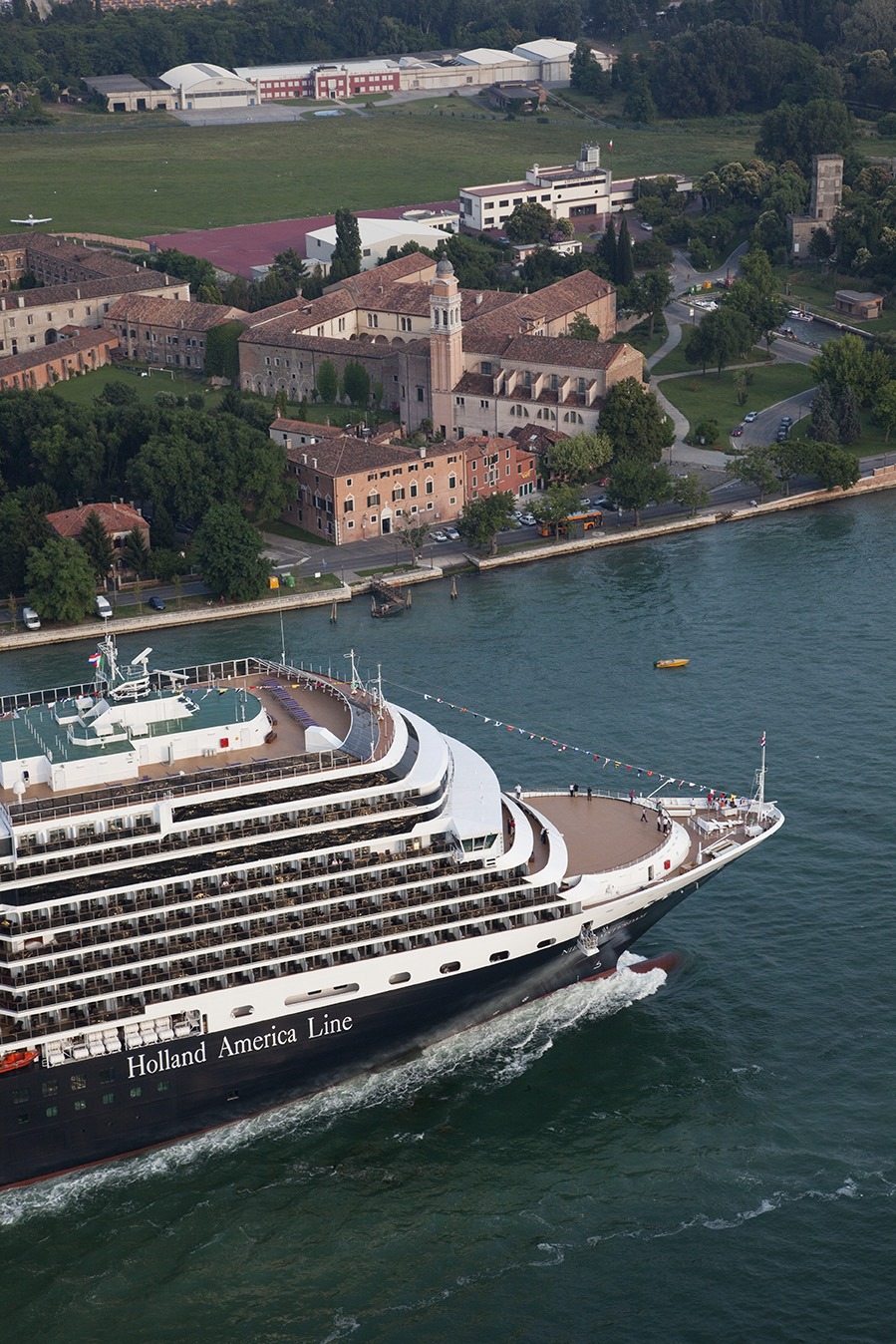
Rotterdam- to the Third Power
Rotterdam – to the Third Power
A Porthole writer takes a trip down Holland America Line’s memory lane.
By Ben Lyons
Peering outside the windows of my water taxi as it sped down the River Maas in Rotterdam, I saw the gently curved stern of the former Holland America Line flagship ss Rotterdam. Fourteen years ago, as a ship-obsessed Midshipman at the US Merchant Marine Academy, I had a similar, but closer, view from a tugboat in New York. Somehow managing to hitch a ride on the tugboat docking the ship on its last New York visit, I remember reaching up and touching the “R” in Rotterdam welded on its stern.
Years later — and still ship obsessed — I ventured to the city of Rotterdam for a maritime celebration. I planned to wallow in nostalgia, explore Holland America’s tangible links to its former home city, tour the refurbished ss Rotterdam, now a museum and hotel ship, and board the current flagship ms Rotterdam for a crossing to New York. My plan was straightforward: I was going to Rotterdam to see one Rotterdam before embarking on another Rotterdam!
Today, few companies tout — or even have — heritage. Gone are the days when flagships were embodiments of national pride and prestige. Now, ships are mostly registered in Panama or the Bahamas, and the economic benefits of employing 50 different nationalities outweigh patriotic sentiments. Holland America, however, remains one of the few lines that continues to celebrate its past. Its ships fly the Dutch flag, employ mostly Dutch officers, and often recycle famous names from the past.
So when the line announced that it would send the 1997-built ms Rotterdam (the sixth ship to bear the name) on the first traditional Atlantic crossings from Rotterdam to New York and back in 40 years, I decided to join the festivities. Promised events included a grand sail away from the city of Rotterdam, a temporary shipboard museum, lectures on ocean liner history, and many fellow liner enthusiasts.
City Stories
For my pre-crossing time in Rotterdam, spending at least one night at the Hotel New York was a must. The former headquarters of Holland America from 1901 to 1977, the hotel exudes the line’s history. Large golden letters on the outside still proudly spell out HOLLAND AMERIKA LIJN, and the location could not be more convenient. The cruise terminal is only a few hundred feet away. (Holland America’s new European offices are similarly close, situated on a street named for one of the line’s founders.)
Inside, I found Holland America posters gracing the walls of the lobby. In the popular and well-attended bar, young couples flirted next to a dramatic model of the former liner Nieuw Amsterdam. Old deck plans decorate corridors; a wall in a function room is covered with a huge North Atlantic chart. Even the rooms are nautically decorated, with ship searchlights dangling from the ceiling and overblown images of life at sea covering the walls. Two suites occupy the space of the former boardroom of the company, with towering windows overlooking the river. That I loved the hotel was not surprising; that its unusual history has made it such a surprisingly hip destination, however, was unexpected.
The next morning, I traded in the buzzing atmosphere of the bar for a decidedly more cerebral setting: the City Archives. At its peak, Holland America was to Rotterdam what Microsoft is to Seattle, dominating the city’s life and industry. The archives house one of the largest collections of Holland America memorabilia in the world, stretching almost 2,000 feet and taking up more than 3 percent of the entire city archives.
While I had no intention of examining the archive’s more than 100 Holland America posters, 330 postcards, 800 passenger lists, 5,800 logbooks, and a multitude of photographs, the ship geek in me jumped at the chance to view as much as I could in my short time. I pored over logbooks from ss Rotterdam in the 1960s, a 1911 dinner menu on an earlier Rotterdam, and black-and-white photographs depicting previous Holland America ships sailing from the same pier from which I would soon depart. Most poignant to my upcoming crossing was a passenger list from another Rotterdam-to-New York crossing on the fourth flagship Rotterdam, which was in 1910.
Leaving the archives, I paid a quick visit to the large Maritime Museum (which occasionally hosts Holland America exhibits) before checking out of the Hotel New York. After my water taxi ride, I would be checking into my second nostalgic hotel.
An Oldie But Goodie
Built in 1959, ss Rotterdam saw distinguished service as both a trans-Atlantic liner and cruise ship. In 1997, Holland America sold it to Premier Cruises, who renamed the ship Rembrandt, and its wide promenades, tiered open decks, and virtually intact 1950s interior made it a sentimental favorite of cruisers until Premier’s 2000 bankruptcy forced the ship into retirement.
Having sailed on the ship as Rembrandt three times, I worried that the multiyear conversion into a museum might have destroyed the charm. Would the many clever and unique quirks in its design have been changed? Would I find the ship desolate and empty?
To my relief, I discovered the Rotterdam looking resplendent. Its hull has been restored to its original color scheme, and the main public rooms appear almost exactly as they did when originally built. A painstaking amount of research and effort has been dedicated to restoring even the tiniest detail in the artwork. Today, in addition to its role as a hotel, visitors can tour the ship, eat dinner on board, or have a drink in the Ocean Bar. Formerly off-limit spots such as the bridge and engine room are open for guided tours.
Modern Moments
The next afternoon, I stepped through almost 40 years of maritime design to embark ms Rotterdam. Its balcony cabins, culinary art center, and atrium were a clear sign of modern tastes. Berthed with Maasdam, the two ships were the center of a daylong pierside celebration. By the evening, the crowd had swelled to several thousand gathering to send off Rotterdam while a singer crooned “New York, New York.” Holland America clearly still resonates with Rotterdam’s citizens.
Suddenly, the ship’s whistles sounded, and my inevitable excitement at sailing increased again. Hundreds of balloons were released, waves and blown kisses were exchanged with those on the pier, and, almost imperceptibly, Rotterdam began moving.
Moments later, we were passing the gleaming letters on the Hotel New York, the gold lettering reflecting the setting sun. After turning around, Rotterdam was now bound downriver, and as we passed ss Rotterdam a few minutes later, champagne glasses were raised in a toast as the two flagships exchanged booming whistle salutes. Exiting the River Maas and entering the North Sea, fireworks erupted from shore in tribute. We were now bound across the Atlantic.
During the crossing, nostalgia ran high, and I delighted in the tributes to the older liner that I found subtly incorporated in the newer ship. A model of the former flagship graced the entrance of the newer vessel’s dining room, and an onboard mural echoed the stunning black-lacquer one found in the older vessel’s Ritz Carlton Lounge. Most importantly, I felt that unique ambiance and rhythm — that can only be felt while crossing the ocean — take hold of the ship.
Like countless others had done on the old Rotterdam, I spent hours on the promenade, slowly circling the deck while watching the ocean hiss by. I noticed the decade gradually become unimportant, and it mattered little whether the ship was built in 1997 or 1959. A crossing is timeless, and for this week aboard Rotterdam, Holland America’s past was alive and well.








